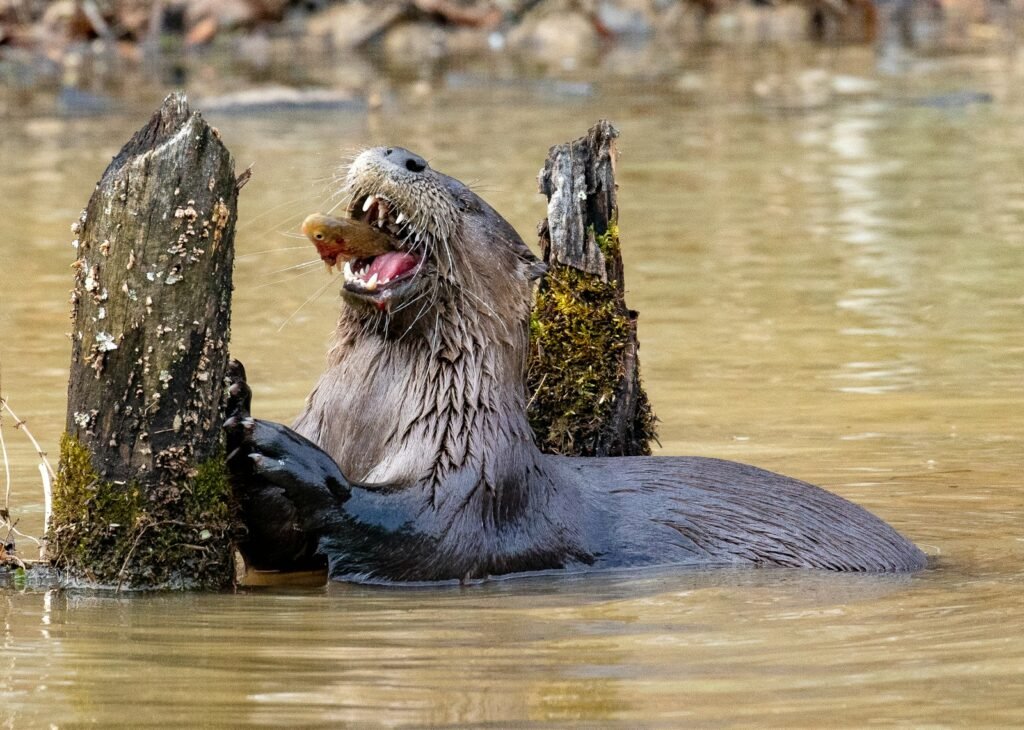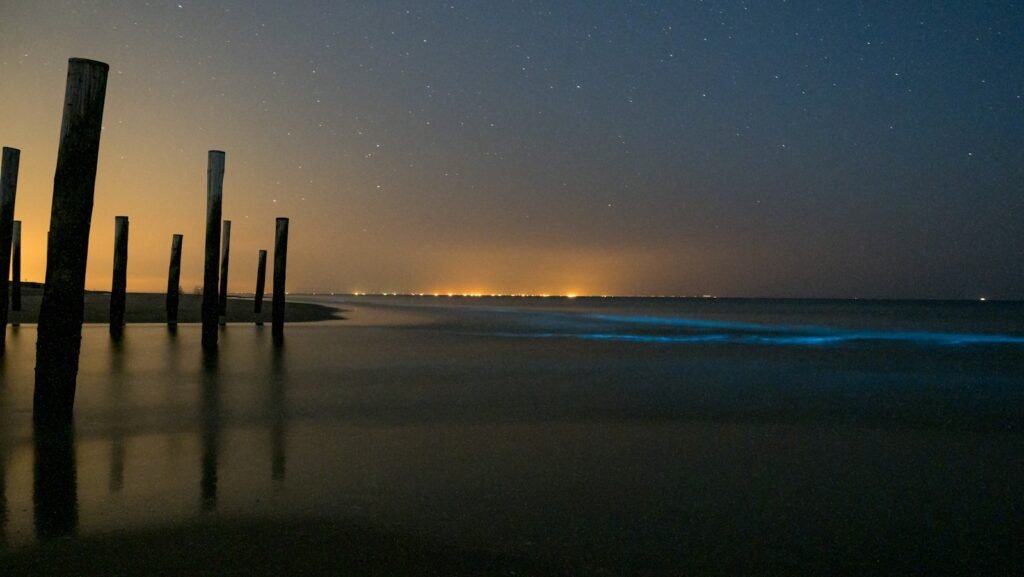At dawn on a glassy backwater, a whiskered head breaks the surface where, for decades, nothing but an oil-slick rainbow once shimmered. The comeback isn’t accidental. It’s the visible result of years of patient wetland restoration, dam removals, and the slow cleaning of rivers that once ran brown. River otters, long absent from some of New Jersey’s most industrialized creeks, are slipping back into the story – sudden, sleek proof that ecosystems can recover when given room and time. Their return doesn’t erase a century of damage, but it reframes the future in a way that feels honest and hopeful. The mystery now is not whether otters can live here – it’s how far their recovery will ripple across our waters and our communities.
The Hidden Clues

What tips scientists off isn’t always a splash; it’s a smear of fish scales, a crescent paw print in gray mud, a belly-slide on snowy banks. River otters are notoriously difficult to spot, so biologists read the river like a detective novel – following scat, tracks, and feeding remains that map out quiet territories. Trail cameras stationed on culverts and marsh edges are catching late-night cameos in places that used to be lifeless.
Those signposts matter because they chart more than an animal’s route; they trace a system healing from the bottom up. Where minnows and crayfish rebound, otters follow, turning murky channels into living corridors again. In a state as densely built as New Jersey, each verified crossing or slide mark is a small, thrilling headline.
From Ancient Tools to Modern Science

A century ago, people tracked otters with little more than sharp eyes and a trapper’s intuition. Today, researchers add methods that would’ve seemed like science fiction: environmental DNA for detecting otter skin cells in water samples, machine-learning models that predict occupancy, and high-resolution satellite imagery that shows where wetlands hold water the longest.
These tools, paired with old-school winter sign surveys, tell a consistent story. Otters prefer clean, connected waters with dense bankside cover, and they’re highly sensitive to the breaks and bottlenecks we create. When restoration stitches habitat back together – even a few miles at a time – models and cameras start to agree: the odds of otter presence climb.
Decades of Absence, Explained

The early and mid-1900s were brutal on New Jersey’s waterways: rampant pollution, channelized streams, marshes filled or cut off, and unregulated harvest pushed river otters out of many urban and suburban stretches. It wasn’t one blow but a long grind of small losses that hollowed out the food web. By the time modern protections tightened, some creeks had become ecological dead ends.
Step by step, that trend reversed. Wetland restorations reopened tidal flow, stormwater controls reduced raw overflows, and contaminated sites began the slow work of cleanup and compensation. Along major watersheds like the Raritan, planned dam removals and floodplain reforestation projects are restoring movement and food supply – exactly the ingredients a wide-ranging carnivore needs to move back in.
Wetlands at Work

Otters are picky in a very practical way: they go where the buffet is reliable and the water is breathable. Restored marshes deliver both by filtering nutrients, cooling summer flows with shade, and rebuilding submerged vegetation that shelters prey. Think of a healthy wetland as a breathing lung attached to a river; every tide in and out scrubs and feeds the system.
On the ground, that looks like reconnected creeks, invasive reed removal, and replanting with native shrubs and trees – tens of thousands of them across floodplains. With time, fish, frogs, and crayfish rebound, and the river’s food web knits itself together. The moment you see fresh otter slides, you’re looking at the dividend of all that unglamorous restoration labor.
Why It Matters

This isn’t just about a charismatic animal returning; it’s a stress test our rivers are finally passing. As mid-level predators, otters are living readouts of water quality and connectivity. Where they appear, contamination is lower, passage is better, and the prey base is robust enough to support a family through winter.
Compared with traditional water testing, otter presence integrates dozens of variables at once – hydrology, habitat structure, contaminant loads, and food availability – over months, not minutes. It’s the difference between a single blood test and a full body scan. For policy makers and local residents, that makes otters a compelling, plain-language metric: if they’re back, something is working.
Numbers, Not Just Nostalgia

Anecdotes make headlines; data sustains recoveries. Recent occupancy modeling in New Jersey streams, plus ongoing state monitoring, shows how land use, stream order, and wetland cover shape otter presence. Restoration agencies are layering those findings onto maps to prioritize culvert fixes, dam removals, and floodplain reforestation where they’ll matter most.
Consider these benchmarks that drive decisions:
- Healthy otter territories typically stretch across multiple miles of connected waterways, linking marsh, creek, and mainstem river.
- Where floodplains are reforested, summer water temperatures trend cooler, improving oxygen levels that fish – and otters – need.
- Removing even a single low-head dam can reconnect many miles of habitat, unlocking prey movements and predator foraging routes.
- Long-term monitoring programs use carcass contaminant testing and camera data to watch for legacy pollutants and track population health.
Global Perspectives

Here’s the twist: while many of the world’s otter species are declining, North America’s river otter is bucking the trend where restoration and regulation are strong. That contrast turns New Jersey’s story into a useful case study for urban regions worldwide. If an apex forager is reclaiming industrial estuaries here, there’s a blueprint others can borrow.
Similar returns have been documented in nearby states and major metro areas, signaling a broader watershed renaissance. Clean water laws, targeted habitat work, and collaborative funding models are the through-line. The lesson is pragmatic and exportable: fix flow, clean sediments, replant banks, and protect corridors, and the food web – otters included – will often do the rest.
The Future Landscape

The next decade will test whether recovery can outpace the pressures of climate change. Sea-level rise threatens to drown low marsh unless inland migration routes and floodplain room are secured, and more intense rainstorms can flush pulses of contaminants and warm runoff into stressed creeks. Legacy toxics buried in sediments will need careful management as shorelines erode.
On the upside, new tools are arriving fast. Environmental DNA sampling can flag otter presence from a liter of water, AI can scan thousands of camera images for a whiskered muzzle, and sensor networks can trigger rapid habitat fixes when oxygen crashes. Pair those technologies with greenway projects that link neighborhoods to restored banks, and you get both ecological resilience and public buy-in.
How You Can Help

Recovery accelerates when everyday choices line up with river health. Keep trash and pet waste out of storm drains, plant native shrubs to buffer runoff, and steer clear of sensitive marsh edges during pupping season. If you boat or paddle, slow down near emergent vegetation and give wildlife plenty of room.
Support local land trusts, watershed groups, and volunteer plantings; small grants and Saturday mornings add up to miles of better habitat. Report credible otter sightings to state wildlife officials or community-science platforms so managers can refine maps and investments. In a state where every acre counts, your shoreline matters more than you think.

Suhail Ahmed is a passionate digital professional and nature enthusiast with over 8 years of experience in content strategy, SEO, web development, and digital operations. Alongside his freelance journey, Suhail actively contributes to nature and wildlife platforms like Discover Wildlife, where he channels his curiosity for the planet into engaging, educational storytelling.
With a strong background in managing digital ecosystems — from ecommerce stores and WordPress websites to social media and automation — Suhail merges technical precision with creative insight. His content reflects a rare balance: SEO-friendly yet deeply human, data-informed yet emotionally resonant.
Driven by a love for discovery and storytelling, Suhail believes in using digital platforms to amplify causes that matter — especially those protecting Earth’s biodiversity and inspiring sustainable living. Whether he’s managing online projects or crafting wildlife content, his goal remains the same: to inform, inspire, and leave a positive digital footprint.




